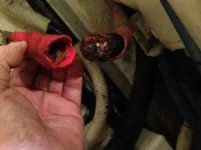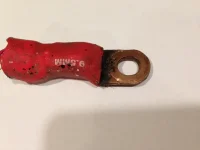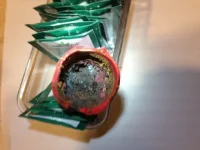Milacron
Well-known member
- Joined
- Mar 22, 2015
- Messages
- 830
- Status
- OWNER - I own a Hatteras Yacht
- Hatteras Model
- Not Currently A Hatteras Owner
(boatsb is going to love this... )
Recently my port 12v71TA starter would not start. Below is why. Cable is 4/0 welding wire with the usual black SO type rubber jacket but also encased in heavy PVC like flexible conduit (the red cover you see)



Notice there are no cracks or corrosion outside the connector (which connects to the + starter solenoid stud) and notice it is sealed with sealant of some sort. The connector faced up, wire went down....so even if there was some salt spray from a small cooling system leak nearby I don't see how the water could have entered the crimp fitting.
So, after 22 years....how did this happen ? I have two theories....
1. Perhaps years ago the connector was not sealed so well, a cooling leak developed that got into the wire. Someone came along, cleaned up the mess, repainted the starter and surrounds and sealed the connector. But the salt water was already in the copper, gradually doing what you see.
2. Vibration. That red cover is quite heavy and stiff... I can see the possibility of vibration fatiquing a few strands, internal sparking going on...which makes matters even worse breaking more strands, rinse and repeat for 22 years.
Curiously, the starboard engine cable is fine...showing near zero ohm resistance. But I should probably go ahead and replace it's cable as well.
Would ABYC cable avoided this ?
Recently my port 12v71TA starter would not start. Below is why. Cable is 4/0 welding wire with the usual black SO type rubber jacket but also encased in heavy PVC like flexible conduit (the red cover you see)



Notice there are no cracks or corrosion outside the connector (which connects to the + starter solenoid stud) and notice it is sealed with sealant of some sort. The connector faced up, wire went down....so even if there was some salt spray from a small cooling system leak nearby I don't see how the water could have entered the crimp fitting.
So, after 22 years....how did this happen ? I have two theories....
1. Perhaps years ago the connector was not sealed so well, a cooling leak developed that got into the wire. Someone came along, cleaned up the mess, repainted the starter and surrounds and sealed the connector. But the salt water was already in the copper, gradually doing what you see.
2. Vibration. That red cover is quite heavy and stiff... I can see the possibility of vibration fatiquing a few strands, internal sparking going on...which makes matters even worse breaking more strands, rinse and repeat for 22 years.
Curiously, the starboard engine cable is fine...showing near zero ohm resistance. But I should probably go ahead and replace it's cable as well.
Would ABYC cable avoided this ?


